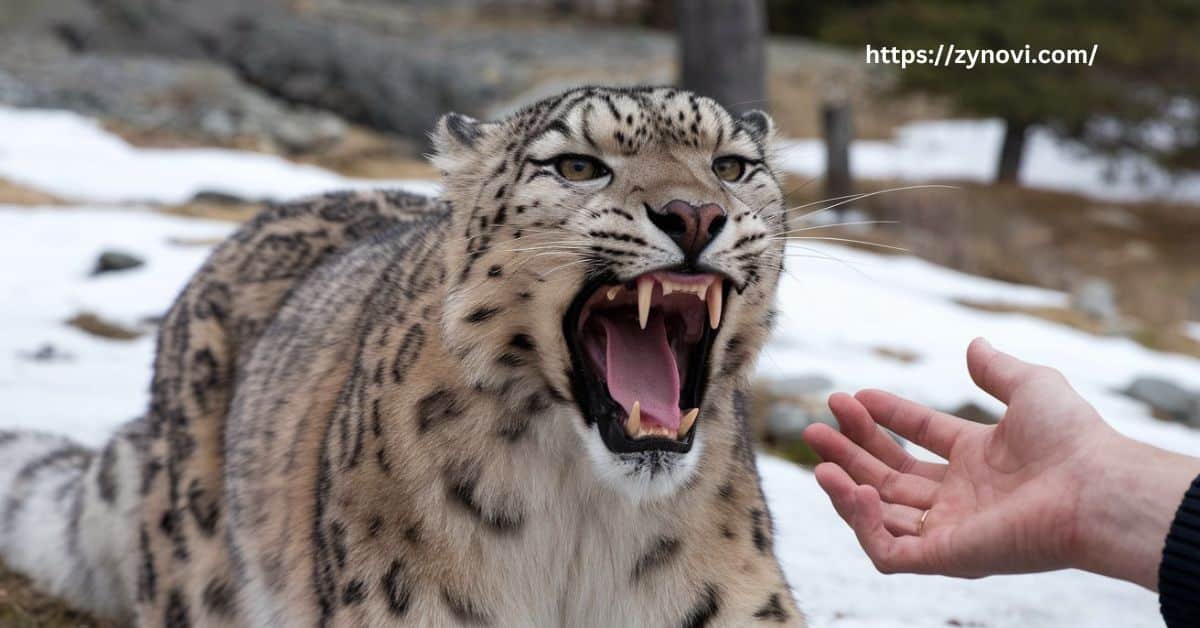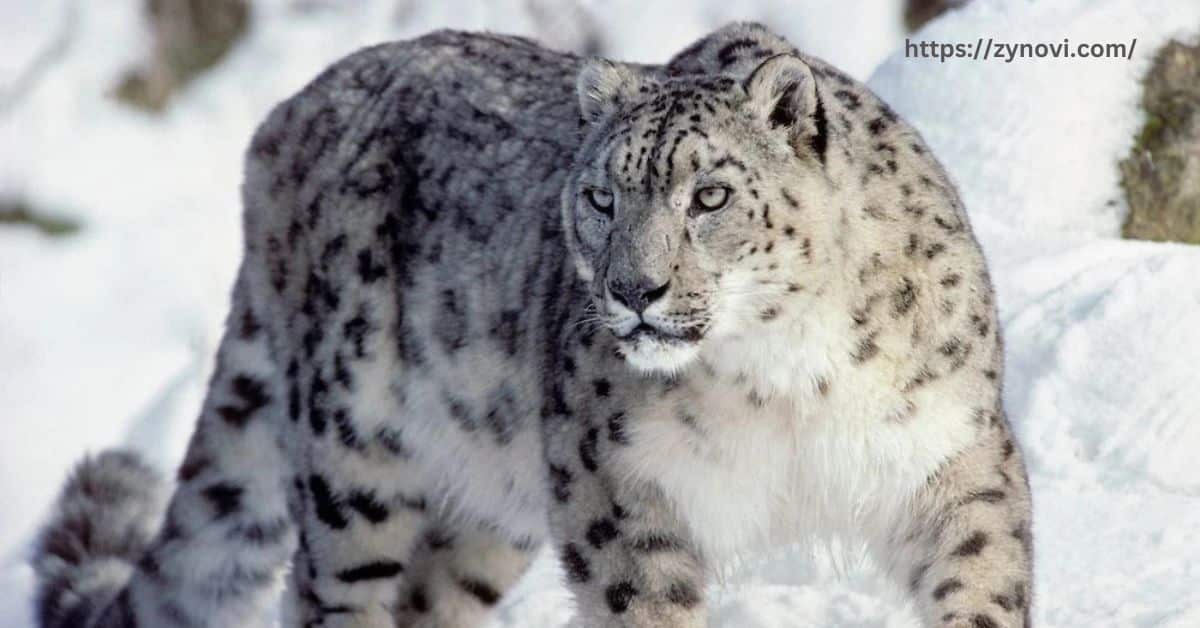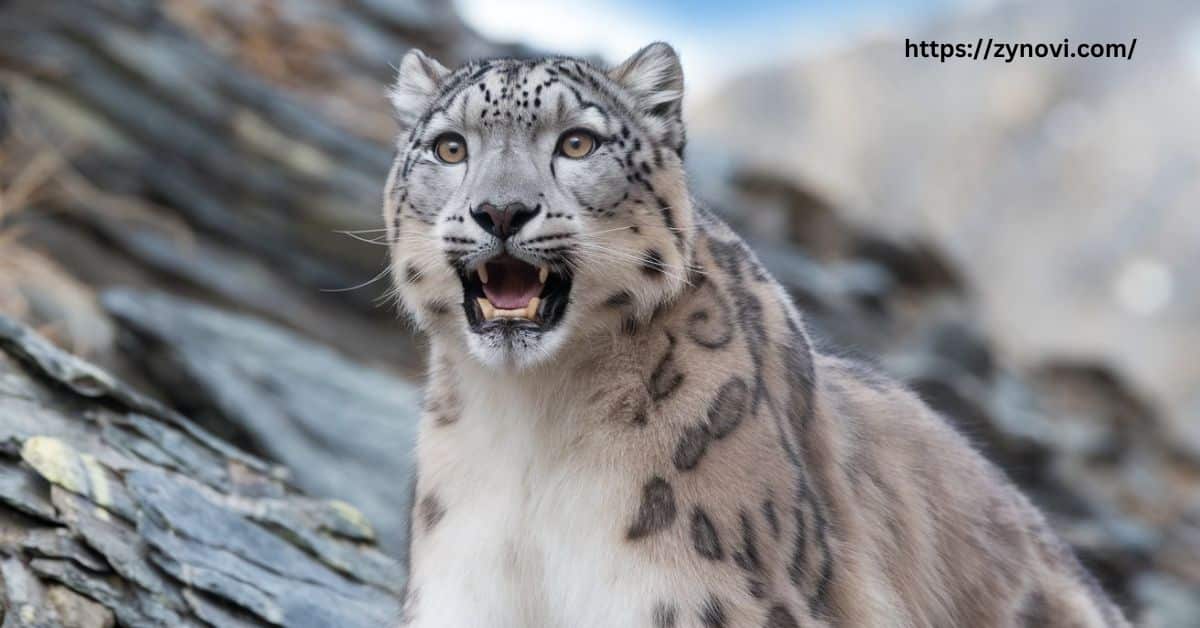Do snow leopards attack humans? No, snow leopards rarely attack humans and are generally shy, solitary animals that avoid human contact.
It’s a question that sparks curiosity and concern, especially for those who venture into the rugged, high-altitude regions they call home. These elusive big cats are often surrounded by mystery, but understanding their behavior can ease your fears and deeper appreciation of their role in the wild.
In this article, we’ll explore the truth behind snow leopard attacks, shedding light on their natural instincts, their interactions with humans, and the vital role they play in preserving the ecosystem.
What Are Snow Leopards?
Snow leopards (Panthera uncia) are large cats native to the rugged, high-altitude mountain ranges of Central Asia, South Asia, and parts of China, India, Mongolia, and Nepal.
These big cats are known for their smoky-gray coats with black rosettes, which provide them with excellent camouflage in the rocky, snow-covered landscapes they inhabit.
Physical Features
- Size: Snow leopards are medium-sized cats, with males typically weighing between 90-120 pounds and females between 60-100 pounds. Their long, bushy tails add to their length, often measuring up to 36 inches.
- Adaptations for Cold Environments: Snow leopards have thick fur, large nasal cavities, and powerful hind legs that help them navigate the steep terrain and rocky landscapes. These adaptations are crucial for survival in their cold, mountainous habitats.
Diet and Hunting
As apex predators, snow leopards primarily prey on animals like blue sheep, ibex, argali, and smaller mammals such as marmots and hares.
They are ambush predators, relying on stealth and camouflage to approach their prey unnoticed.
They often hunt alone and are known for their ability to take down prey much larger than themselves.
How Do Snow Leopards Interact with Humans?

Snow leopards are solitary animals by nature and are not inclined to seek out human interaction. They are nocturnal, preferring to stay active during the night when it’s quieter and less likely that humans will encroach on their territories.
But when it comes to human interaction, snow leopards are generally peaceful, avoiding humans whenever possible.
Natural Behavior and Diet
- Solitary Nature: Snow leopards are known for their elusive and solitary behavior. They typically roam alone, except during mating seasons or when a mother is caring for her cubs. This isolation reduces the chances of human encounters.
- Prey Selection: As ambush predators, snow leopards are highly specialized in hunting wild prey like blue sheep and ibex, and they rarely attack humans. Their diet is mainly composed of herbivores that are abundant in their natural habitat.
Encounters Between Humans and Snow Leopards
Snow leopards generally avoid human settlements, staying in remote areas where livestock predation or human settlements are less common.
However, in some cases, when their habitat is encroached upon, they may wander closer to human activity, increasing the chance of interaction.
This is particularly true when overgrazing by livestock diminishes their natural prey, forcing them to venture into human-populated areas.
Do Snow Leopards Pose a Threat to Humans?
Do Snow Leopards Attack Humans? Despite their fearsome reputation as apex predators, snow leopards are not a threat to humans. However, like any wild animal, they can become dangerous if they feel threatened or cornered.
Historical Incidents
Historically, snow leopards have rarely attacked humans. There are occasional reports of attacks on people, often when the animal is provoked or threatened.
Retaliatory killings have also occurred when snow leopards prey on livestock, which is a common practice in regions where snow leopards and human settlements overlap.
Insights from Scientific Research and Experts
According to experts from organizations like the Snow Leopard Trust and the World Wildlife Fund (WWF), the number of human attacks by snow leopards is extremely low.
In fact, most scientific research suggests that snow leopards prefer to stay away from humans and rarely engage unless provoked.
The true danger lies more in the human-wildlife conflict, particularly when snow leopards are driven closer to human settlements due to habitat loss or poaching.
Why Snow Leopards Rarely Pose a Threat to Humans

Snow leopards are notorious for their elusive nature and preference for isolation, which makes human attacks rare. There are several reasons why they are unlikely to attack humans.
Behavioral Traits
- Prey Selection: Snow leopards are ambush hunters, perfectly adapted to stalking and pouncing on wild prey like blue sheep, ibex, and argali. Their hunting strategy involves waiting patiently for the right moment, using their excellent camouflage to remain unseen. Humans, however, do not appear in their typical diet, as they primarily target herbivorous animals in their mountainous environments.
- Stealth and Avoidance: Snow leopards are known for their remarkable stealth, using their smoky-gray coats with black rosettes to blend into the rocky landscapes. They are not naturally aggressive toward humans. When encountering people, snow leopards often choose to retreat, preferring to avoid confrontation and maintain their solitary, elusive nature.
Risk Avoidance
- Avoiding Human Settlements: Snow leopards are not territorial in the sense that they actively defend against humans. Instead, they avoid contact with people altogether, especially in areas where human settlements are common.
- Retaliatory Killings: In rare cases, snow leopards may attack livestock if they are unable to find natural prey. This often leads to retaliatory killings by local communities, but again, this is not a direct attack on humans.
How to Respond if You Encounter a Snow Leopard
Though the likelihood of encountering a snow leopard is low, it’s important to know how to behave if you do. Here are some important safety tips:
- Stay Calm:
It’s crucial to remain calm and composed during the encounter. Avoid panicking, as sudden movements can make you appear threatening or unpredictable, which may provoke a response from the snow leopard. Take deep breaths and focus on staying steady. - Do Not Run:
Running away might trigger the snow leopard’s chase instinct, making it more likely to pursue you. Instead of running, maintain a calm demeanor and avoid any erratic movements. Stay where you are or back away slowly to give the animal space. - Make Yourself Appear Larger:
Snow leopards are cautious creatures, and making yourself appear larger can help deter them. Stand tall and, if possible, raise your arms or open up your jacket to increase your perceived size. This might make the leopard reconsider its approach. - Back Away Slowly:
If the snow leopard is not moving away, slowly retreating is your best option. Keep facing the animal and step backward without turning your back. To avoid being seen as a threat, move calmly and steadily instead of making quick or sudden actions.
Snow Leopard Conservation: Status and Threats

Snow leopards are listed as an endangered species by the International Union for Conservation of Nature (IUCN), with an estimated population of fewer than 7,000 individuals remaining in the wild.
Their survival is threatened by multiple factors, including poaching, habitat loss, and human-wildlife conflict.
Habitat Loss and Poaching
- Habitat loss is one of the major threats to snow leopard populations, with expanding human settlements and overgrazing pushing them out of their natural environment.
- Poaching is another serious issue. Snow leopards are hunted for their thick fur and bones, which are used in traditional medicine.
Climate Change
- As climate change alters the alpine and subalpine zones, snow leopards face a loss of their natural prey and habitat. This leads to more encounters with human populations as the animals are forced to move to lower altitudes.
The Importance of Snow Leopards in Their Ecosystem
Snow leopards play a crucial role as apex predators in maintaining the balance of their ecosystem. By controlling populations of herbivores like blue sheep and ibex, they help prevent overgrazing and maintain a healthy balance between species.
- Role in Ecosystem Balance:
- Snow leopards play a crucial role in maintaining the ecosystem balance by controlling the populations of herbivores such as blue sheep and ibex. By keeping these species in check, they prevent overgrazing, which helps preserve the vegetation and overall health of the high-altitude habitats.
- Cultural Significance:
- In many remote regions of Central and South Asia, snow leopards are revered as symbols of power, grace, and strength. Their presence in local folklore highlights their cultural importance and the deep connection between the animal and the communities living in these mountainous areas.
Final Verdict
Snow leopards are not dangerous to humans, with attacks being extremely rare. Their shy, solitary nature and ambush hunting behavior make them more likely to avoid humans. Conflicts usually arise from habitat loss and livestock predation rather than predatory behavior.
Through continued conservation efforts and responsible human interactions, we can ensure snow leopards thrive in their natural habitats, maintaining the crucial balance in high-altitude ecosystems for generations to come.
FAQs
Has anyone been attacked by a snow leopard?
Snow leopard attacks on humans are extremely rare, with only a few documented incidents, often in situations of conflict or provocation.
Would a leopard attack a human?
Leopards typically avoid humans but may attack if threatened or cornered, especially in areas where their natural prey is scarce.
Are leopards friendly to humans?
Leopards are not domesticated and are generally wary of humans, preferring solitude and avoiding interaction.
Are snow leopards good pets?
No, snow leopards are wild animals with specialized needs and behaviors that make them unsuitable as pets.
Conclusion: Do Snow Leopards Attack Humans?
In conclusion, snow leopards are elusive, solitary animals that typically pose little threat to humans. Their natural instinct is to avoid conflict, and they do not seek out human interaction. However, as these magnificent creatures face increasing threats from habitat loss, poaching, and climate change, it remains vital to support conservation efforts.
By preserving their natural habitats, practicing peaceful coexistence, and educating local communities, we can ensure snow leopards continue to thrive in the wild. Protecting them will not only help maintain ecosystem balance but also safeguard the cultural heritage of regions that revere these awe-inspiring big cats.










